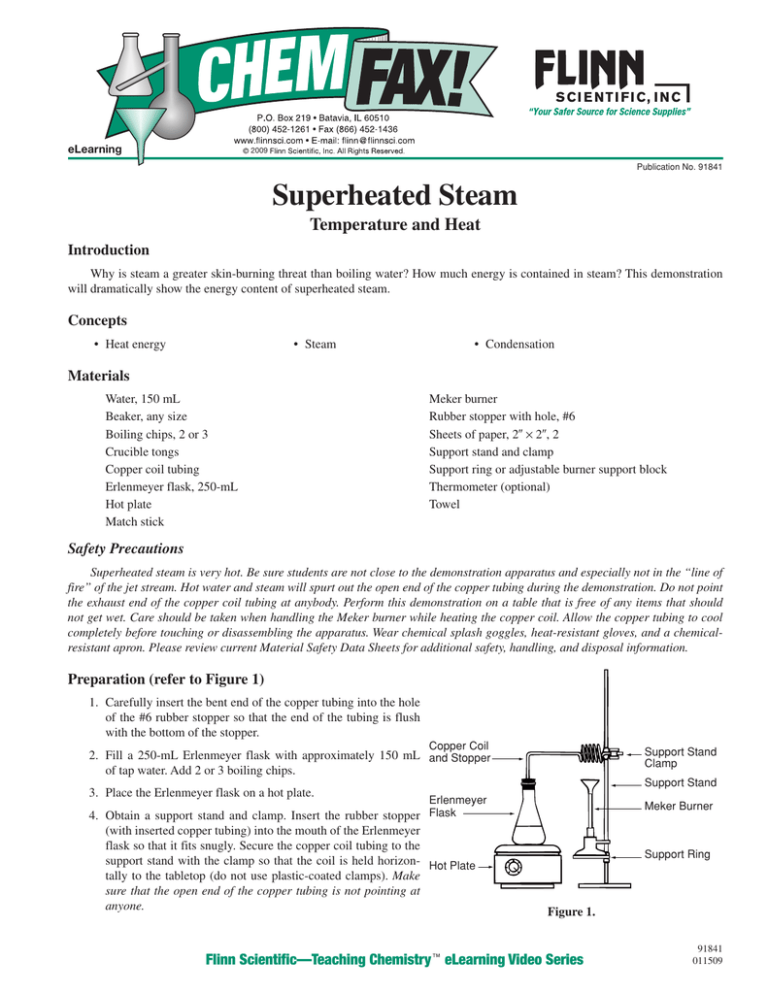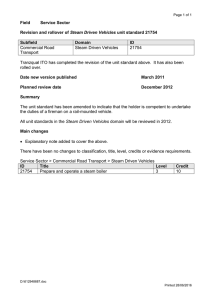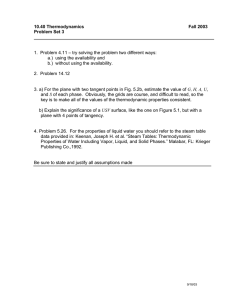
eLearning
2009
Publication No. 91841
Superheated Steam
Temperature and Heat
Introduction
Why is steam a greater skin-burning threat than boiling water? How much energy is contained in steam? This demonstration
will dramatically show the energy content of superheated steam.
Concepts
• Heat energy
• Steam
• Condensation
Materials
Water, 150 mL
Beaker, any size
Boiling chips, 2 or 3
Crucible tongs
Copper coil tubing
Erlenmeyer flask, 250-mL
Hot plate
Match stick
Meker burner
Rubber stopper with hole, #6
Sheets of paper, 2 × 2, 2
Support stand and clamp
Support ring or adjustable burner support block
Thermometer (optional)
Towel
Safety Precautions
Superheated steam is very hot. Be sure students are not close to the demonstration apparatus and especially not in the “line of
fire” of the jet stream. Hot water and steam will spurt out the open end of the copper tubing during the demonstration. Do not point
the exhaust end of the copper coil tubing at anybody. Perform this demonstration on a table that is free of any items that should
not get wet. Care should be taken when handling the Meker burner while heating the copper coil. Allow the copper tubing to cool
completely before touching or disassembling the apparatus. Wear chemical splash goggles, heat-resistant gloves, and a chemicalresistant apron. Please review current Material Safety Data Sheets for additional safety, handling, and disposal information.
Preparation (refer to Figure 1)
1. Carefully insert the bent end of the copper tubing into the hole
of the #6 rubber stopper so that the end of the tubing is flush
with the bottom of the stopper.
Copper Coil
Support Stand
Clamp
2. Fill a 250-mL Erlenmeyer flask with approximately 150 mL and Stopper
of tap water. Add 2 or 3 boiling chips.
3. Place the Erlenmeyer flask on a hot plate.
Support Stand
Erlenmeyer
4. Obtain a support stand and clamp. Insert the rubber stopper Flask
(with inserted copper tubing) into the mouth of the Erlenmeyer
flask so that it fits snugly. Secure the copper coil tubing to the
support stand with the clamp so that the coil is held horizon- Hot Plate
tally to the tabletop (do not use plastic-coated clamps). Make
sure that the open end of the copper tubing is not pointing at
anyone.
Meker Burner
Support Ring
Figure 1.
Flinn Scientific—Teaching Chemistry eLearning Video Series
91841
011509
5. Place a Meker burner beneath the copper coil on a support ring or adjustable support block so that the Meker burner flame
will effectively heat the copper coil.
6. Place a few towels (paper or cloth) on the tabletop a foot or two in front of and beneath the exhaust end of the copper tubing to collect any water that will spurt out the end as the water and steam are heated. (Some of the steam condenses in the
tubing and forms liquid water that is eventually pushed out by the flowing steam.)
7. Turn on the hot plate. Adjust the temperature control to the highest setting.
8. Once the water is boiling steadily and visible exhaust steam is seen flowing out of the copper tubing, follow the procedure
below. If necessary, adjust the temperature control on the hot plate to maintain a rapid boil.
Procedure
1. Have students observe the steam flowing from the end of the copper tubing. Ask students: What is the temperature of the
steam? (It can be assumed to be approximately 100 °C or it can be measured by carefully placing the tip of a thermometer
into the steam.) Is the steam a liquid or a gas? (Many will say it is a gas.) Why? (Actually, the “steam” they see is condensed particles of water—it is in liquid form.)
2. Grip the end of a small sheet of paper with crucible tongs and place the sheet into the exhaust steam at the end of the copper tubing. (Nothing happens, except the paper may become wet.) Remove the paper from the steam.
3. Ignite the Meker burner and adjust the flame so that it is effectively heating the copper coil. The steam will disappear
within a few seconds as it turns into superheated steam. Ask students what state the water is in now? Why? Was the visible
“steam” they observed earlier really a gas?
4. Carefully grasp a cool beaker with crucible tongs and place the side of the beaker in the superheated steam. The invisible
gaseous water condenses on the beaker. (This shows that the water vapor is still there, but it is now in a true gaseous state.
It condenses when it strikes a colder object—and it releases energy, see Discussion.)
5. Continue heating the copper coil with the Meker burner for a minute or two (until the coiled copper tubing gets red hot).
6. Grip the end of a small sheet of paper with the crucible tongs. Keep the paper clear of the Meker burner flame. Place the
sheet of paper in the superheated steam exhaust about 1–2 cm from the end of the copper tubing. The paper will char and
turn black!
7. Next, grip the base of a match stick with crucible tongs. Place the head of the match in the superheated steam exhaust
about 1–2 cm from the end of the copper tubing. It will ignite! Water (superheated steam) can be used to light a match!
Disposal
Please consult your current Flinn Scientific Catalog/Reference Manual for general guidelines and specific procedures governing the disposal of laboratory waste. The water may go down the drain. The boiling chips can go into the trash. The copper oxide
formed on the outside of the copper tubing and the depleted copper tubing can be placed in the trash according to Flinn Suggested
Disposal Method #26a.
• Slightly heating the copper coil in the beginning will help to evaporate any condensed water that may be trapped in the
coils. This will help make a more visible “steam” cloud for procedure steps 1 and 2.
• When the copper coil is heated it turns black as copper oxide forms on the surface. This oxide will flake off as the copper
coil cools. After the demonstration, turn off the Meker burner and move it to the side. Place a towel (cloth or paper) on the
tabletop below the coil to collect the flaking copper oxide that falls from the coil. Once the coil has cooled to room temperature, the remaining copper oxide can be removed with a brush or towel. Please see the Disposal section for appropriate disposal procedures.
• If a Meker burner is not available, a Bunsen burner can also be used. The superheated steam may not reach as high a temperature so it may take longer for the superheated steam to char the paper. Also, the flame may not have a wide enough
area to heat the entire coil like a Meker burner so it may be necessary to use a flame spreader or wing top. Another option
is to hold the Bunsen burner at the base and slowly and continuously move the flame across the coil so that the entire coil
heats evenly. Please use extreme caution when handling an ignited Bunsen burner.
–2–
© 2009 Flinn Scientific, Inc. All Rights Reserved.
91841
• For a more dazzling display, flash paper can be used. It will ignite in the superheated steam! Flash paper can be found at
many magic shops.
• After each demonstration, the thickness of the copper tubing will be slightly thinner due to the formation of copper oxide
(on the outside and the inside of the copper tubing) that eventually flakes off. Therefore the life span of the copper coil is
limited. It should last for 10–20 demonstrations.
Discussion
An important concept of this activity is that, initially, the steam flowing from the copper tubing is not truly gaseous water.
Gaseous water cannot be seen by the naked eye. Visible steam is actually composed of very tiny liquid water droplets that are suspended in the air. When water is heated to 100 °C (at sea level; slightly less for higher elevations), it begins to boil because there is
sufficient energy to change the state of water from liquid to gas. The invisible gaseous water molecules break away from the surface of the water and rise. If there are enough water molecules leaving the surface at the same time, then there is a high tendency
for them to collide with each other and interact to form tiny droplets of water as they rise above the surface. We associate these
tiny visible water droplets that rise from a pot of boiling water or escape from a heated tea kettle as “steam.” The tiny water droplets do eventually break apart and form gaseous water molecules as the droplets flow to a less concentrated region and equilibrate
with the surrounding air molecules. When the steam rises from the water and into the heated copper coil, the heating evaporates
the tiny water droplets (again). The temperature of the gaseous water increases beyond 100 °C so the water molecules have too
much kinetic energy to condense to the tiny droplets again. This is why the steam disappears when the copper coil is heated.
Why does the paper char when held in the superheated steam? As gaseous water (or any gas) condenses to form a liquid, the
molecules are going from a higher energy state to a lower energy state. Therefore, energy (in the form of heat) must be released.
The amount of heat energy released is associated with the specific heat of gaseous water (33.1 J/mol°C at 1 atm), the heat of
vaporization of water at 100-°C (40600 J/mol at 1 atm) and the specific heat of liquid water (75.3 J/mol°C at 1 atm). Note that
the heat of vaporization of water is much larger than the specific heat of water. This means that most of the released heat energy
is associated with the condensation of water vapor. Much more heat is released during the condensation process at 100 °C than
when water (liquid or vapor) cools even several hundred degrees! For example, when one mole of water vapor at 100 °C cools and
condenses to liquid at 99 °C, 40675.3 J of heat is released. Compare this to one mole of boiling water at 100 °C that cools to 99
°C. Only 75.3 J of heat is released. Therefore, when water vapor strikes a colder object (such as skin) and condenses to the liquid
state (at 100 °C) it releases a larger amount of heat energy compared to boiling water (also at 100 °C) that heats an object. This
is why steam causes severe skin burns more rapidly than boiling water. This is dramatically shown when the paper chars in the
superheated steam. The water vapor condenses onto the paper and releases a large amount of energy that raises the temperature
of the paper above its kindling point, or the point at which the material begins to burn. The paper usually will not ignite because
the fast-moving superheated steam flushes away the oxygen as well. However, the match will ignite because its chemical make-up
contains a chemical supply of oxygen (an oxidizer) that will facilitate a flame.
Connecting to the National Standards
This laboratory activity relates to the following National Science Education Standards (1996):
Unifying Concepts and Processes: Grades K–12
Evidence, models, and explanation
Constancy, change, and measurement
Content Standards: Grades 5–8
Content Standard B: Physical Science, properties and changes of properties in matter, transfer of energy
Content Standards: Grades 9–12
Content Standard B: Physical Science, structure and properties of matter, interactions of energy and matter
Answers to Worksheet Questions
1. Note any observations you made regarding the following:
a. The initial appearance of the steam.
The steam looked like a small, thin cloud coming out of the copper tubing.
–3–
© 2009 Flinn Scientific, Inc. All Rights Reserved.
91841
b. What happened when a piece of paper was held in that initial steam?
The piece of paper became wet, but it did not appear to heat up at all.
c. The appearance of the superheated steam.
The superheated steam was not visible.
d. What happened when a beaker was held in the superheated steam?
Water vapor condensed on the side of the beaker, even though the steam could still not be seen.
e. What happened when a piece of paper was held in the superheated steam?
The piece of paper was charred and turned completely black where the steam touched it.
f, What happened when a match was held in the superheated steam?
The match ignited.
2. What state was the initial steam in? What state was the superheated steam in? Explain how the difference occurred.
The initial steam was actually in liquid form—it was composed of tiny water droplets. The droplets were formed due to the
large number of water molecules that were leaving the liquid water in gaseous form at the same time. They interacted with
one another and became liquid again.
3. The specific heat of gaseous water at 100 °C is 33.1 J/moll°C at 1 atm, the heat of vaporization of water at 100 °C is
40600 J/mol°C, and the heat of liquid water at 100 °C is 75.3 J/moll°C. What releases more heat—water condensating
from 100 °C to 99 °C or boiling water cooling to 99 °C?
The water undergoing condensation releases much more heat (40675.3 J) because the heat of vaporization of water is so
much higher than the specific heat of liquid water at 100°.
References
Bilash, B. A Demo A Day: A Year of Physical Science Demonstrations; Flinn Scientific: Batavia, IL, 1997; p 27.
Shakhashiri, B. Z. Chemical Demonstrations, Vol. 2; University of Wisconsin: Madison, WI, 1985; pp 92–95.
Flinn Scientific—Teaching Chemistry™ eLearning Video Series
A video of the Superheated Steam activity, presented by Peg Convery, is available in Temperature and Heat, part of the Flinn
Scientific—Teaching Chemistry eLearning Video Series.
Materials for Superheated Steam are available from Flinn Scientific, Inc.
Materials required to perform this activity are available in the Superheated Steam Demonstration available from Flinn
Scientific. Materials may also be purchased separately.
Catalog No.
AP6158
AP2306
Description
Superheated Steam Demonstration
Rubber Stoppers, Size 6, One-Hold, 1 lb
Consult your Flinn Scientific Catalog/Reference Manual for current prices.
–4–
© 2009 Flinn Scientific, Inc. All Rights Reserved.
91841
Superheated Steam Worksheet
Discussion Questions
1. Note any observations you made regarding the following:
a. The initial appearance of the steam.
b. What happened when a piece of paper was held in that initial steam?
c. The appearance of the superheated steam.
d. What happened when a beaker was held in the superheated steam?
e. What happened when a piece of paper was held in the superheated steam?
f. What happened when a match was held in the superheated steam?
2. What state was the initial steam in? What state was the superheated steam in? Explain how the difference occurred.
3. The specific heat of gaseous water at 100 °C is 33.1 J/moll°C at 1 atm, the heat of vaporization of water at 100 °C is
40600 J/mol°C, and the heat of liquid water at 100 °C is 75.3 J/moll°C. What releases more heat—water condensating
from 100 °C to 99 °C or boiling water cooling to 99 °C?
91841
© 2009 Flinn Scientific, Inc. All Rights Reserved. Reproduction permission is granted only to science teachers who have purchased Temperature and Heat in the Flinn Scientific—Teaching
Chemistry™ eLearning Video Series. No part of this material may be reproduced or transmitted in any form or by any means, electronic or mechanical, including, but not limited to photocopy, recording, or any information storage and retrieval system, without permission in writing from Flinn Scientific, Inc.





